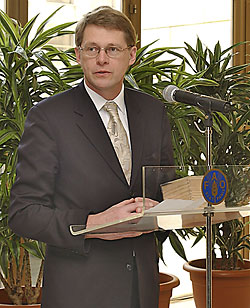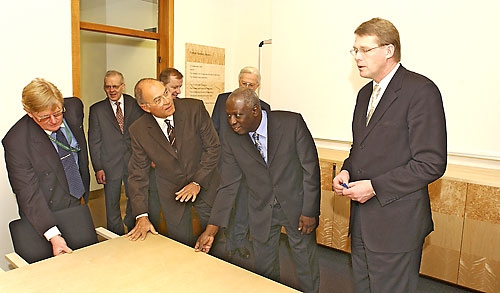


M. Vanhanen
Matti Vanhanen is the Prime Minister of Finland
The Prime Minister of Finland, addressing the opening session of COFO on 15 March, underlined the role of sustainable forest management in his country’s development.
First of all I would like to thank FAO for giving me the pleasure and honour to address you today. As the Prime Minister of a country that has built much of its prosperity on its forests while increasing the extent and environmental values of its forest cover, it is most appropriate that I am here at FAO today to share our experience with you. Finland is a living example that the sustainable use of forests is feasible.
In few countries have the forest cluster industries been so important for economic development as in Finland. At the same time, the conservation of forest reserves began early and the proportion of conserved forests has grown and is today in Finland larger than anywhere in the European Union (EU). The history of conservation measures is a long one. On the basis of a law for nature conservation from 1923, nine national parks and fourteen nature reserves had been established by 1956. By the end of the 1970s conservation areas covered 6 700 km2, mainly forest areas. The forest areas that were already included in these early nature protection measures included many wilderness environments. The planning for protected areas and establishment of these reserves have continued. At the beginning of 2005 the network of protected areas, which mainly includes forests, covers about 10 percent of the Finnish land area and includes 35 national parks, 12 wilderness areas, 407 nature reserves or other State-owned protected areas and more than 4 000 privately owned nature reserves. The total of protected areas, 31 330 km2, exceeds the area of Belgium. In addition, a political decision in principle to preserve an additional 7 000 km2, corresponding to 2 percent of the land area, is already made.
Compared in several ways, not only quantitatively, the conservation of forests is on a higher level in Finland than anywhere in the EU. Facts speak for themselves. Wilderness in Finland has been well protected for many decades. I do not see much merit in allegations that invoke conservation issues to incite international opinion against logging in Finland.
I would like to continue with four international policy topics. The first one is sustainable forest management, which leads us to the second one, the Millennium Development Goals and the role of forests in achieving these. The third issue is national forest programmes and their potential role in mobilizing additional financing for forestry. The fourth topic is the role of science-based information in sustainable development. I shall occasionally return to the Finnish example under these topics.
The Finnish people have always had a close relation to forests, with a long history of forest conservation that is promoted to children as well as adults |
 |
FINNISH FOREST ASSOCIATION/E. OKSANEN |
Forests are essential to ensure environmental sustainability. More than one-third of the land area of our planet is covered by forests. Forests serve many kinds of expectations and needs. For many they are the source of the basic necessities we need to survive: food, medicines, shelter or fuelwood. Forests are also a source of pure drinking-water and raw material for wood-based industry. They may also be a place to go hiking or camping, or even a place for practising cultural and spiritual traditions.
In Finland forests mean all the things I mentioned. The Finnish way of life has always relied on a close relation to our forests. The population of Finland constitutes nearly one-half of the world population living north of 60° latitude. In difficult climatic circumstances forests provide many ways to improve livelihoods. We extract wood from the forests for industrial use, and still today it is very popular to collect berries and mushrooms. At the same time the area protected under different schemes is growing and prospects to restore positive trends regarding biodiversity are improving.
Considering these, sustainable forest management today encompasses, in addition to stable economic growth, also environmental, social and cultural sustainability. Therefore it is becoming a more complex challenge to balance private and public interests, needs of present and future generations, environmental and economic benefits and cross-sectoral impacts. Forestry must address increasingly complex demands from a growing number of users. A balance should be found at the local level; otherwise real sustainability may not be achieved.
The broad concept of sustainable forest management was introduced at the United Nations Conference on Environment and Development, and since then it has been discussed in many international forest-related events. Now there is an urgent need to bring this concept into practice. Finland believes that there is a need for a flexible legal instrument at the international level, which would offer a solid and sound framework for action by the States and the different stakeholders.
Prime Minister of Finland Matti Vanhanen at FAO |
 |
FAO/I. BALDERI |
The Millennium Development Goals are accompanied by a set of time-bound and measurable targets for combating poverty, hunger, diseases, illiteracy, environmental degradation and discrimination against women. Development funding is coordinated to promote these goals. A challenge for today is to establish how forestry can best contribute to the achievement of the goals through sustainable policies and practices. In my view, this is both necessary and achievable.
Sustainable forest management promotes the Millennium Development Goals in several ways. The most obvious role for forests is related to the goal of ensuring environmental sustainability. Good natural resource management improves peoples’ livelihoods, income, food security and health. Improved water quality reduces child mortality. In many ways, forests contribute to the eradication of extreme poverty and hunger.
The opportunities offered by the forest sector need to be emphasized, both in the FAO programmes and in the different national programmes of its members. I know that yesterday the ministers responsible for forests also discussed the Millennium Development Goals and the potential of forests in poverty reduction. The task that you have before you is important. You are the ones who need to promote the recommendations in your respective countries among decision-makers, politicians and authorities in other sectors, making full use of the political support you heard yesterday.
Let me turn to address national forest programmes. All through the past decade, various intergovernmental activities have made progress. Yet the homework needs to be done at home. It is the governments that are primarily responsible for implementing international commitments and incorporating them into national legislation and national policies. In the forest sector, the vehicle for this work, the national forest programmes, have already been recognized internationally as a policy framework since 1992. During the past decade, FAO has worked hard to develop this concept.
Once commitments have been appropriately incorporated nationally, it is much easier to share experiences and learn from one another on the international level. Based on national experiences, FAO is better equipped to tell what kind of tools, projects or normative work is required to facilitate the work in different countries. FAO is doing a good job in supporting national forest programmes. Finland was one of the initiators of the National Forest Programme Facility, a multi-stakeholder partnership between FAO and several governments and international organizations. Finland continues to support its work.
As already mentioned, forests are extremely important for the welfare of the whole Finnish population and for the economic development of the country. Forests are also the most important element of the Finnish nature and a foundation of the way of life and the culture of the Finnish people. With this background, Finland’s national forest programme is a particularly important policy instrument and stakeholder forum for us.
The present national forest programme was approved by the Finnish Government and published in 1999. The fundamental idea is that a competitive forest cluster, together with the fact that forests are a renewable resource, constitutes an excellent foundation for sustainable development. The programme points out that forests are influenced by many different policies, including the policies governing industries, labour, land use, traffic, energy, competition, rural development, education, social affairs and the environment. Good collaboration is needed with all these sectors to ensure that forestry aspects are integrated into their policies, while the perspective of all those sectors are also included in the forest programme. The implementation of the national forest programme will suffer if this reciprocal integration does not work.
At the beginning of this year the Finnish Government adopted a programme for promoting the use of wood and wood construction. Wood is technically an excellent construction material and wooden houses are in demand where available. The use of wood promotes the use of renewable resources and used on a large scale captures carbon dioxide from the atmosphere. In countries where construction traditions rely on other materials, construction in wood may require adaptation of technical provisions. Wood can also be used in many ways. I would like to mention that a Finnish Forestry Room on the premises of the FAO Forestry Department will be inaugurated tomorrow. I suggest that you visit it some time during this week and have a look at the very creative wooden design.
A carefully prepared national forest programme is an excellent resource allocation tool. From the Government’s viewpoint, the national forest programme helps to assess the need for resources to be allocated through the Government budget, but it also encourages the forest owners and forest industries to invest. This is even more important in developing countries where the national forest programme should also be used in the negotiations with potential donors. Therefore it should be integrated with overall poverty reduction strategies, and similarly, international development financing institutions and agencies should integrate forest interventions into their poverty reduction policies. Also in FAO’s programmes the links between poverty reduction and forestry should be clearly visible.
Knowledge is key in today’s society, and the demand for scientific information keeps growing. Finland has responded to this demand by investing more in research. Thanks to this, Finland now ranks second among the nations of the world in the share of research in gross domestic product. Our goal is to continue to increase research funding in the future.
Knowledge is key to the forest sector as well. As non-renewable resources are becoming scarce, new innovations and technologies are needed for promoting the use of bio-based resources in the economy. Forests and use of wood will play a major role. New innovations and technologies require research. Therefore, forest management and conservation as well as the development of processes and products must be based on research. Interaction with industrial innovation must be close.
Innovative and sustainable use of forest resources demands an efficient and well-structured research system. However, research results have little value if they are not used. Research should be an integral part of all national and international policy processes. To facilitate this, we need fora that connect the research community to decision-makers and other users of research results. It would be very useful to consider what kind of mechanisms would be the most effective for this purpose.
It is my sincere conviction that the world’s future rests on the wise use of renewable resources. All of us present here, and FAO through our support, share the responsibility to protect and manage our invaluable forests so that they can be a permanent source of wealth, beauty and biodiversity for future generations. The importance of forests will be increasing, not decreasing, in the future.
FAO has an important and demanding task in promoting international work for sustainable forest management. In the view of my government, FAO has done very well in many respects. I am also pleased to acknowledge that FAO and its members have decided to start an independent external evaluation of the Organization. An outsider’s view may facilitate the further modernization and reform of an organization. I am confident that this initiative will further strengthen the performance of FAO.
Inauguration of the new Finnish Forestry Room at FAO headquarters – from left, front: Hannu Valtanen, Director, Finnish Forest Industries Federation; M. Hosny El-Lakany, Assistant Director-General, FAO Forestry Department; Jacques Diouf, Director-General of FAO; Matti Vanhanen, Prime Minister of Finland; behind: Juhani Karvonen, Executive Director of the Finnish Forest Association; Juha Korkeaoja, Minister for Agriculture and Forestry of Finland; David Harcharik, Deputy Director-General of FAO |
 |
FAO/I. BALDERI |
I would like to conclude by sharing a poverty perspective on the Finnish example. A century ago Finland was one of the most impoverished countries in Europe. The forest cover had been reduced in remote areas by slash-and-burn agricultural practices as well as through production of charcoal near towns and industries. Pictures from deforested lands in the late nineteenth century are very unfamiliar to modern eyes. Also in Finland, poverty and deforestation were linked.
Today Finland is a prime example of a country that has made a huge leap into a high level of development. Much of the industries that made this development possible were based on large-scale use of wood from the forest. Today the forest cluster is still growing and constitutes one of the main pillars of the Finnish economy.
At the same time the forest cover in Finland, more than 70 percent of the land area, is growing and is larger than ever in history, and proportionally larger than in any EU country. Forests in commercial use are well taken care of. A relatively high percentage, more than 60 percent, is owned by private households with an interest in maintaining revenue for generations to come. Any logging is immediately followed by obligatory reforestation programmes. Logging is today adapted to limit damage on biodiversity.
I believe that the case of Finland should encourage us to believe that sustainable forest management is possible and that economic development may be consistent with environmental protection in forestry as well as in general.